�
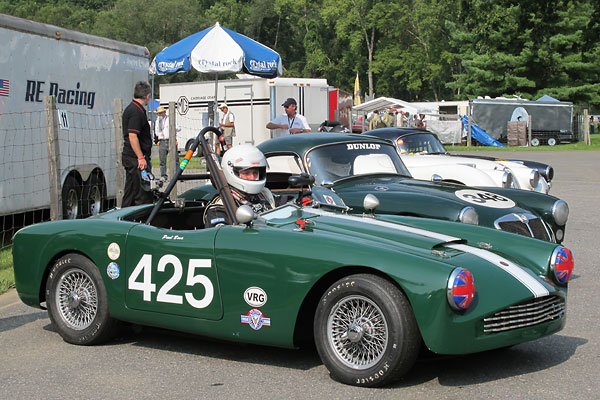
�
Paul Bova and his 1.0L Turner Sports Mk1, ready to race two 1.5L MGAs and a 3.4L Jaguar XK120.
�
Paul and Darry Bova's 1959 Turner Sports Mk1 Race Car
� � Owners: Paul and Darry Bova� City: Stamford, Connecticut
� Chassis: 1959 Turner Sports Mk1
� Engine: BMC A-series 998cc
� Race prepared by: owner and GMT Racing (see below).�
�
Not a Sprite
��
The Turner "Sports" was the third significant car model produced by Jack Turner and his company�
Turner Sports Cars, Ltd. of Wolverhampton. As early as 1951, Turner began offering hand built, aluminum�
bodied, cycle fendered cars on tubular steel frames. Serial production started in 1955 with the "803"�
model (~80 produced) and continued from late 1956 or early 1957 with the updated "950S" model (~170�
produced). These two earlier Turners were named for the respective displacements of the Austin engines�
they used. In addition to engines, Turner also favored Austin axle, suspension, and brake components.�
�
With a new "Sports" model for 1959, company principal Jack Turner hoped to substantially increase�
his company's production rate. Unfortunately for Jack Turner, his early success had apparently�
awoken Austin's executive team. Although Turner Sports Cars had enjoyed wholesale pricing on Austin�
engines and other car components for over three years, friendly business relations soured when�
Austin introduced their own diminutive sporting model: the Austin Healey Sprite.�
Faced with a steep price increase on engines, Turner would have to price his new model higher.�
�
The Turner Sports (Mk1) was introduced to the British market in late 1959, but the earliest contemporary�
magazine feature story we've found about it appeared in the August 1960 edition of The Motor magazine.�
According to that article, the Turner Sports was priced at £645 in kit form, at £815 complete�
with standard Austin engine, at £895 with Alexander Autos and Marine Ltd. prepared engine featuring�
crossflow aluminum cylinder head, and at £1052 as optioned-up to the specification The Motor�
road-tested. For the sake of comparison, Austin Healey Sprites were originally introduced in May 1958�
at a base price of just £679, complete. �
�
�
Within a year, Turner began offering a Mk2 version of the Sports. The new Mk2 featured a Triumph-based�
front suspension. In commercial terms, an even more important difference is that the Mk2 was�
available with a British Ford four cylinder engine. Not wanting to be boxed in again, Turner also�
offered Austin and Coventry Climax engines. Ford engines proved most popular as production�
moved forward through the 1960s. �
�
Please support the sponsoring companies who make www.BritishRaceCar.com possible, including:
� �
 �
�
�
�
Turner Sports Mk1 Number 60-384
� �
Paul and Darry Bova have owned Turner Mk1 number 60-384 since 2002. They've raced it actively in the Northeast �
ever since they got it, typically logging eight to ten race weekends each year. Paul and Darry have raced�
with VSCCA (Vintage Sports Car Club of America), VRG (Vintage Racer Group), SVRA (Sports Car Vintage�
Racing Association) and VSCDA (Vintage Sports Car Drivers Association).�
�
Until recently the Bova team shared this car, with Darry driving in the under-one-liter class race and�
then tossing the keys over so Paul could drive the car in the under-two-liter class. Turners are famous�
for being "giant killers"! Out-running bigger, heavier, larger displacement racecars is a big part of�
the charm of driving a Turner.�
�
Darry has decided to give up driving, but she still serves as Paul's track partner, crew chief, social�
director, and team chef. "We always seem to have a crowd around our motorhome at mealtimes. The social�
aspect of Vintage Racing is a great side benefit of getting people of like minds together for a competitive�
event. Darry prepares excellent meals in our motorhome kitchen, which leads to very pleasant bench racing�
discussions with friends over beers and good food at days end."�
�
When we originally met Paul, he was running a 4.55:1 rear axle ratio. He's now running a 4:88 rear end.�
He explains: "It gives me a little more acceleration coming out of the corners. I will suffer a little�
on top end, but that's not where I am going to catch the bigger displacement heavier cars. I typically�
catch them in the twisty parts and need acceleration to scoot by them."�
�
Paul also shares credit for the car's excellent preparation: "While we do the bulk of the race prep and�
track support ourselves, GMT Racing of Newtown CT has been invaluable for their technical knowledge,�
set-up, fabrication, parts sourcing, and problem solving help. We especially rely on JR Mitchell (owner)�
and Dean Hutchinson (world class fabricator and welder) at GMT. John Leslie at Arjay Racing Engines has�
built winning power plants for us. John knows how to wring every last drop of power out of a BMC 'A' engine."�
�
�
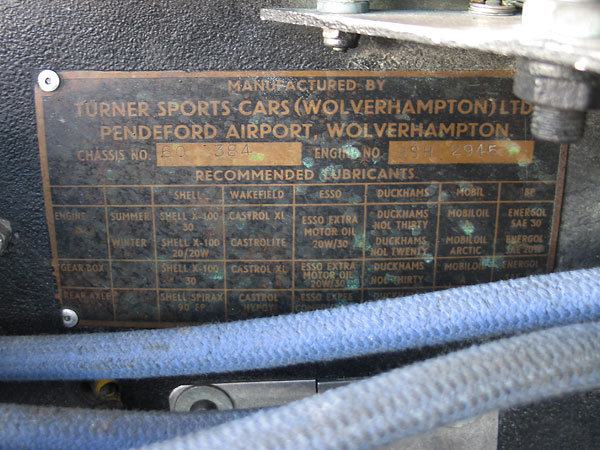
�
Manufactured By: Turner Sports Cars (Wolverhampton) Ltd.
�
Pendeford Airport, Wolverhampton.
�
Chassis No. 60 384 - Engine No. 9SH 2945
�
 �
�
�
�
Features and Specifications (as currently presented)
�| Engine: | �BMC A-series four cylinder engine prepared by John Leslie at Arjay Racing Engines.�
(~84 bhp at 6900rpm and ~72 ft/lbs at 5200rpm.)�
Nominally 948cc, but bored out to 998cc and fitted with AE pistons selected for a static compression ratio of 11:1.�
APT SPVP4-BK scatter pattern camshaft (290/300 degrees duration and 0.324"/0.340" lift.)�
APT valves and guides.�
Roller rockers.�
Gilmer belt drive.�
Dual S.U. HS2 (1.25" bore) carburetors.�
Lucas distributor.�
Lucas electronic ignition amplifier.�
Lucas ignition coil.�
Summit Racing 8mm spiral core spark plug wires.�
Racer Parts Wholesale electronic rev limiter.�
Jaz Products one quart polyethylene crankcase breather tank.�
Deep sump oil pan. | �
| Cooling: | �custom aluminum radiator fabricated by Dean Hutchinson at GMT Racing.�
Electric cooling fan.�
Aluminum swirl pot.�
JAZ Products polyethylene overflow tank. | �
| Exhaust: | �custom three-into-one header and megaphone style exhaust pipe,�
both fabricated by Dean Hutchinson at GMT Racing. | �
| Transmission: | �Jon Stamps Racing prepared close-ratio BMC ribcage 4-speed gearbox.�
Quartermaster 7.25" single disc racing clutch.�
Annular hydraulic throw-out bearing. | �
| Rear Axle: | �reinforced Austin A35 housing.�
Billet axles and double bearing hubs.�
Tran-X limited slip differential.�
4.88:1 gears. | �
| Front Susp.: | �Austin A35 based front suspension (uprights, control arms, steering rack, etc.)�
Billet hubs and spindles.�
World Wide Imports modified (adjustable) Armstrong shock absorbers. | �
| Rear Susp.: | �Torsion bar spring rear suspension.�
Carrera Hypershock gas-charged 2" diameter telescoping shock absorbers. �
Custom Panhard bar. | �
| Brakes: | �(master) Wilwood pedal assembly. Dual Girling master cylinders with a single remote reservoir and remotely-adjustable bias bar. � (front) 9" aluminum-finned drum brakes with Lotus backing plates, Lockheed L320284 cylinders, and Datsun Z springs. � (rear) 8" aluminum-finned drum brakes with Datsun Z backing plates, cylinders, etc. | �
| Wheels/Tires: | �Dunlop 72-spoke wheels. Hoosier Street T.D. tires (A70-13). | �
| Electrical: | �Optima Red Top battery.�
Nippondenso alternator.�
Gear reduction starter.�
Painless Performance Products switch panel, with four fuses. | �
| Instruments: | �(left to right)�
AutoMeter tachometer (0-8000rpm),�
TraqMate GPS data acquisition system,�
Smiths oil pressure gauge (0-100psi),�
Westach dual EGT gauge (700-1700F),�
Smiths coolant temperature gauge (30-110C),�
VDO shift light.�
| �
| Fuel System: | �JAZ Products 10-gallon aluminum fuel tank.�
Facet (Bendix style) electric fuel pump. | �
| Safety Eqmt: | �Kirkey Economy Oval Track seat with its high backrest cut off.�
Adjustable headrest.�
Simpson five point latch and link safety harness.�
Troyer quick release steering wheel hub on a Grant steering wheel.�
FireBottle centralized fire suppression system.�
Amerex handheld Halon fire extenguisher.�
GT Classic side view mirrors.�
| �
| Weight: | �1350# | �
Engine Installation
��
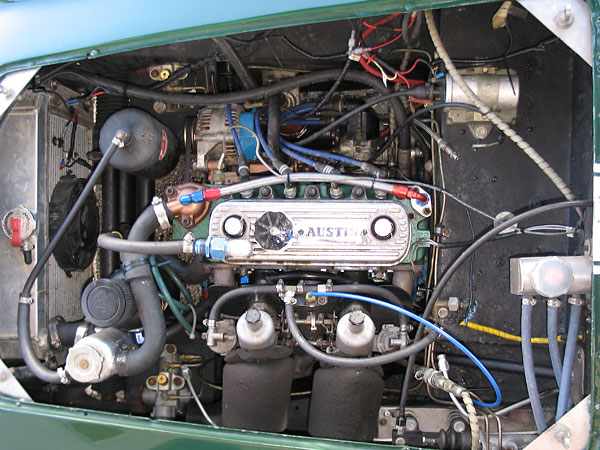
�
Austin-Healey Sprite (a.k.a. BMC A-series) four cylinder engine. This one has been
�
rebuilt with slightly oversize pistons, taking displacement to 998cc.
�
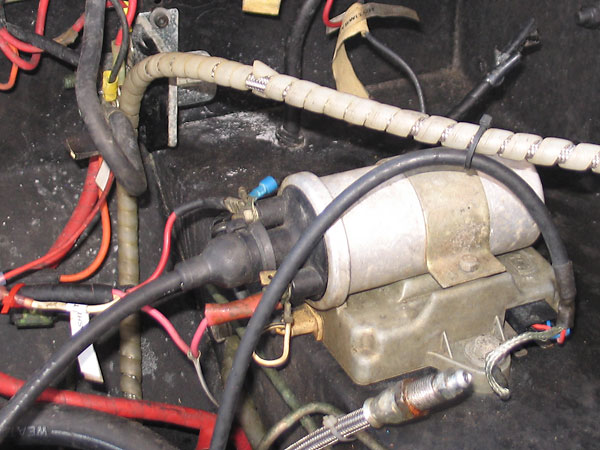
�
The ignition coil is sitting on top of a Lucas electronic ignition amplifier (circa early 1980s.) Used in
�
conjunction with a breakerless Lucas distributor (i.e. with Hall effect sensor and tone wheel in lieu of
�
contact breaker points), the Lucas amplifier reliably provides big, strong, fat sparks! Note: in the
�
foreground you can see the bleeder for a hydraulic throw-out bearing type clutch slave cylinder.
�
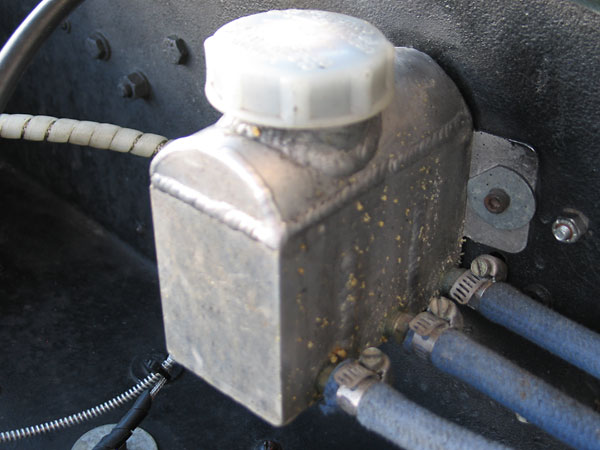
�
Custom fabricated aluminum brake and clutch fluid reservoir.
�
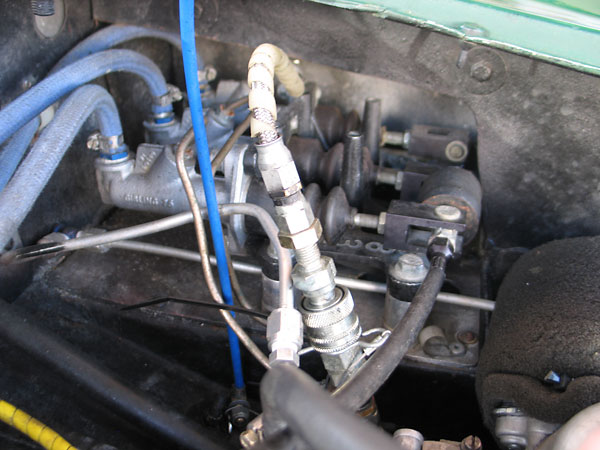
�
Girling master cylinders on a Wilwood pedal assembly. In the foreground you can see a quick disconnect
�
coupling that evidently facilitates disconnecting the clutch hydraulics without spilling any fluid.
�
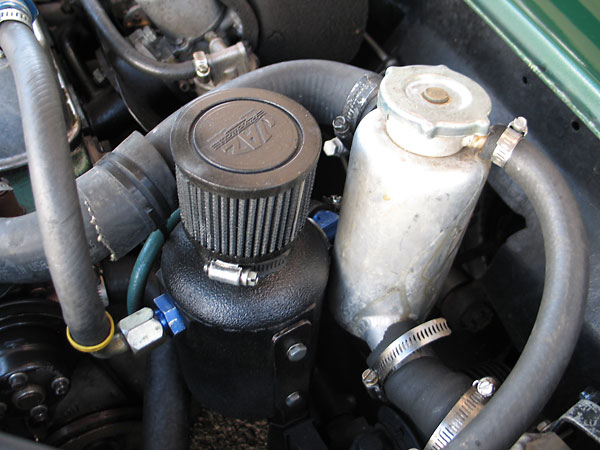
�
Jaz Products one quart polyethylene crankcase breather tank. Aluminum coolant swirl pot.
�
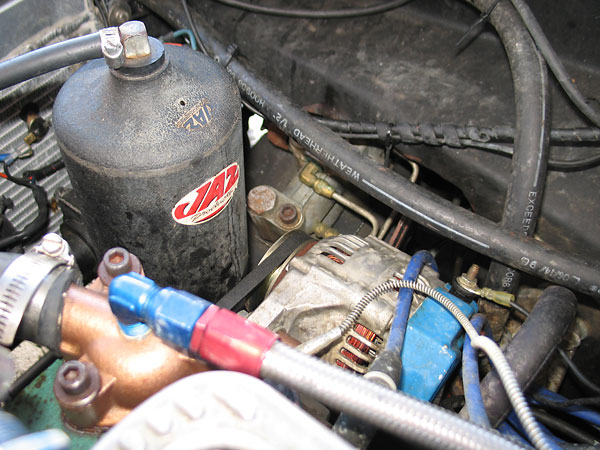
�
JAZ Products polyethylene coolant overflow tank.
�
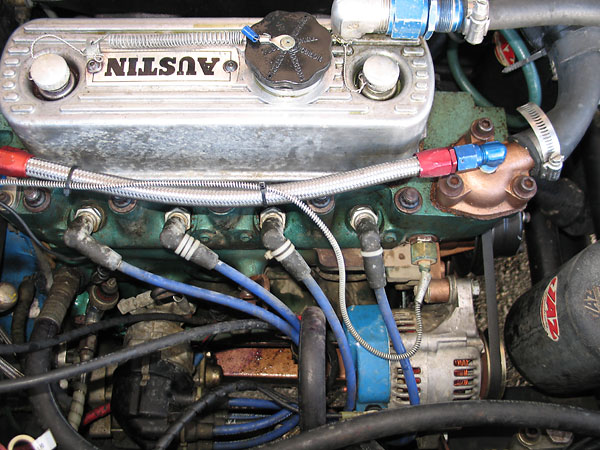
�
Lucas distributor with Summit Racing 8mm spiral core spark plug wires.
�
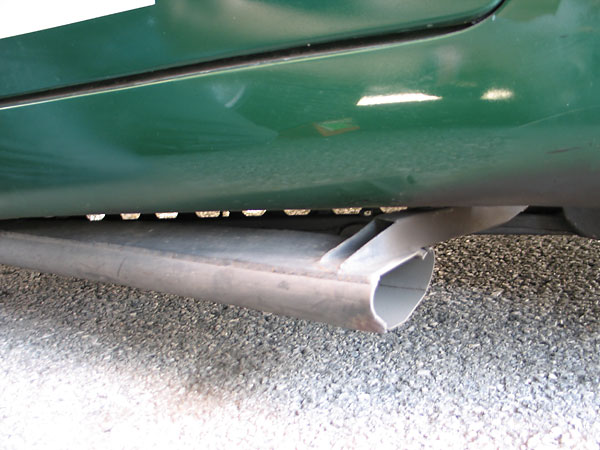
�
Custom megaphone-style exhaust pipe. (In other words, it's been cut and
�
spread open to create an increasingly large cross-section.)
�
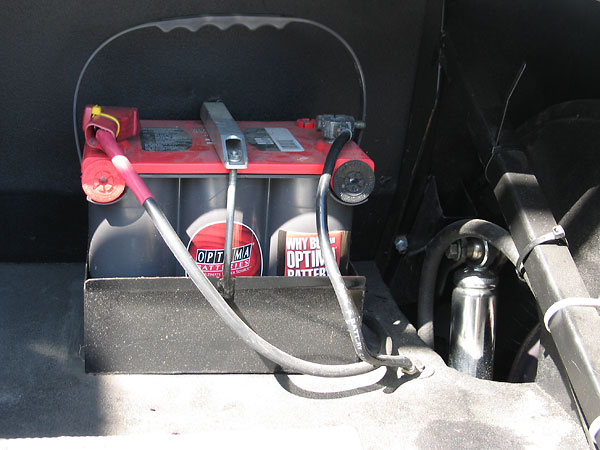
�
Optima Red Top battery.
�
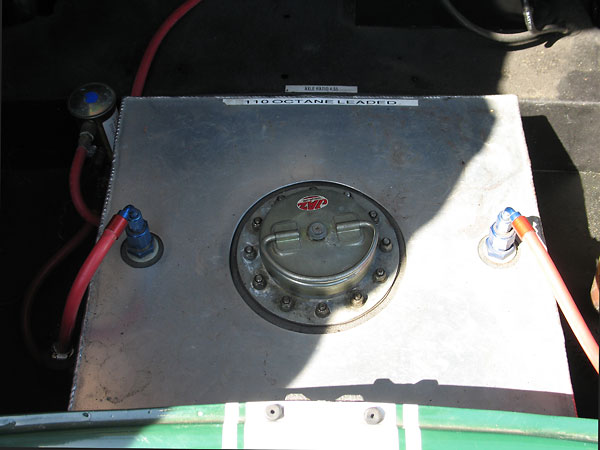
�
JAZ Products 10-gallon aluminum fuel tank. These tanks are safety foam filled to eliminate sloshing,
�
but they don't have the rubber bladder you'd find in an FIA/SCCA approved road-racing fuel cell.
�
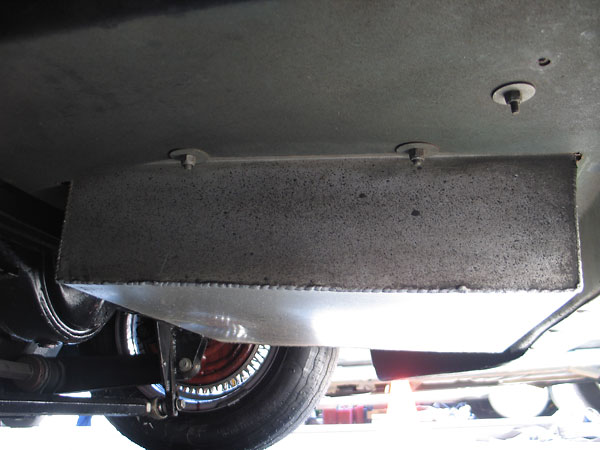
�
Bottom of the fuel tank.
�
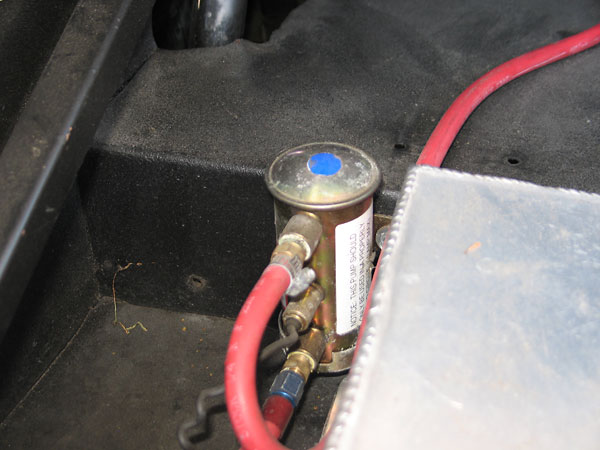
�
Facet (Bendix style) electric fuel pump.
�
Please support the sponsoring companies who make www.BritishRaceCar.com possible, including:
� �
 �
�
�
�
Front Suspension
��
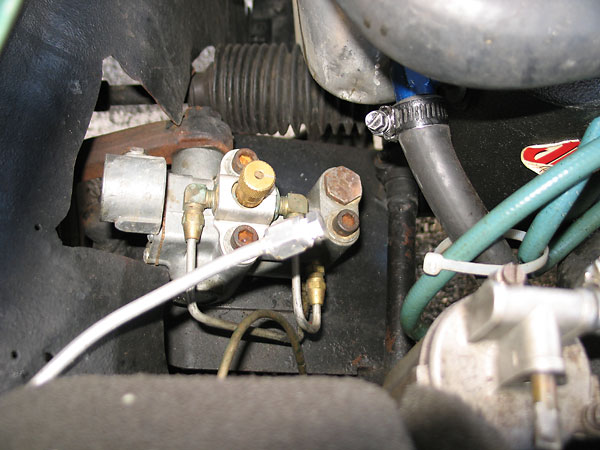
�
World Wide Imports modified (adjustable) Armstrong shock absorbers.
�
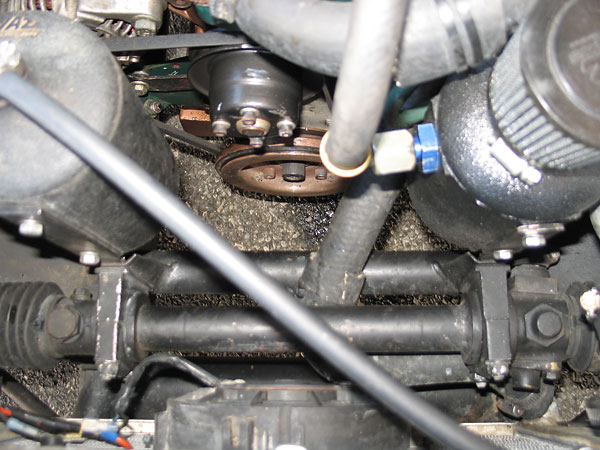
�
Austin A35 steering rack.
�
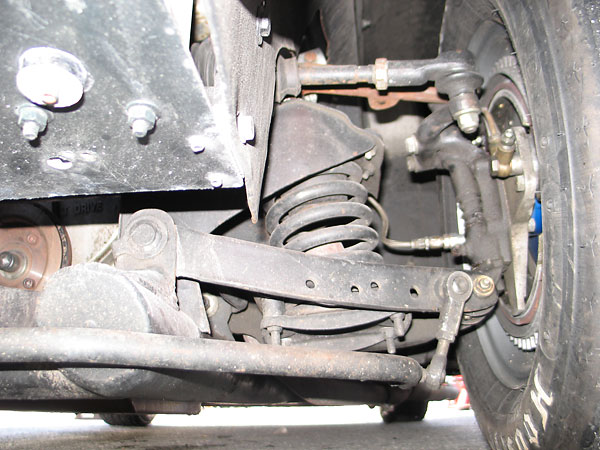
�
This photo shows the single most important difference between Turner's Mk1 and Mk2 models. Through
�
Mk1 production, Turner front suspension's were built around Austin A35 parts just as Austin's Sprite
�
was. From the Turner Mk2 model on, front suspensions were based on Triumph Herald components.
�
(Ford engines were installed in most Turner Mk2s, but Austin engines were offered too.)
�
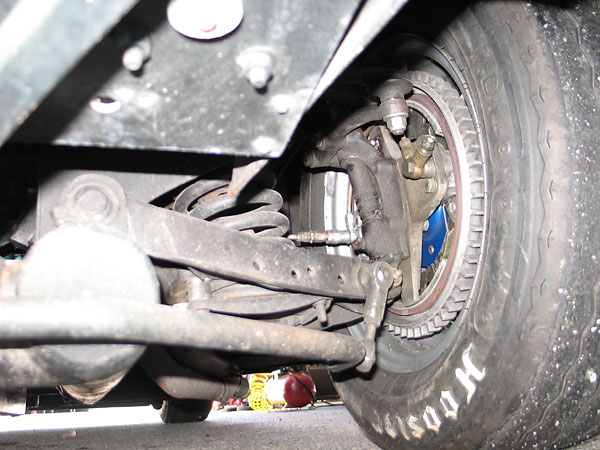
�
Turner offered optional front disc brakes but Paul's Mk1 came with drums. He's made some upgrades:
�
Lotus backing plates, Lockheed L320284 cylinders, Datsun Z springs, and 9" aluminum-finned drums.
�
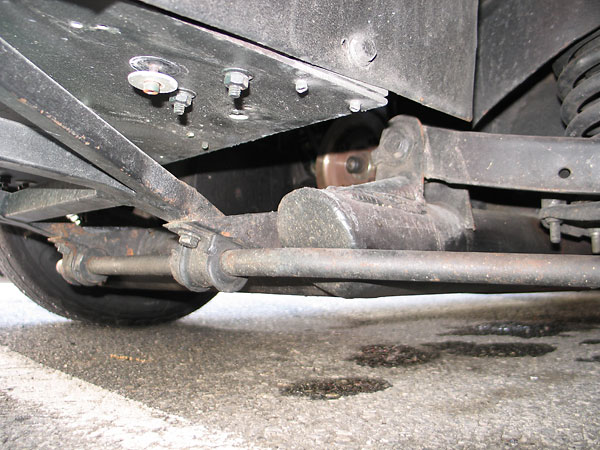
�
Front anti-sway bar mounting details.
�
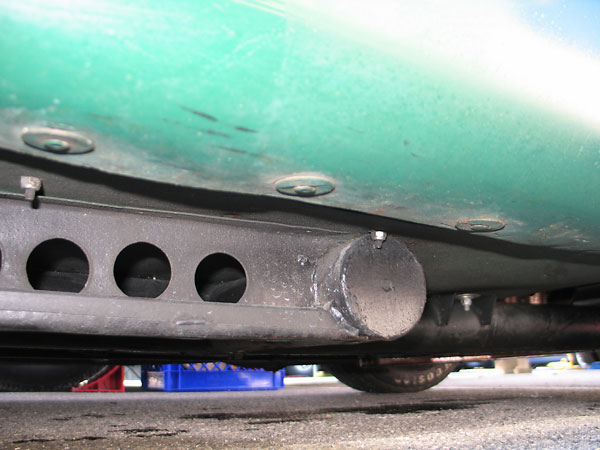
�
The Turner frame is based on two longitudinal steel tubes, supplemented
�
by out-riggers (as shown here) that support the car's fiberglass body.
�
�
Enjoying this article? www.BritishRaceCar.com is partially funded through generous support from readers like you!
�
To contribute to our operating budget, please click here and follow the instructions.
�
(Suggested contribution is twenty bucks per year. Feel free to give more!)�
Rear Suspension
��
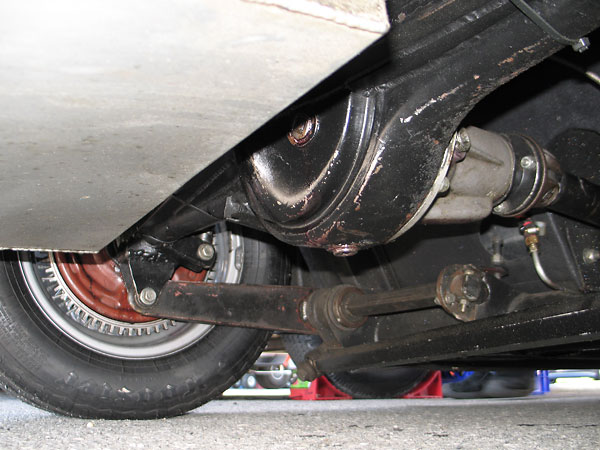
�
Rather than coil or leaf springs, Turner used torsion bar springs for their rear suspensions.
�
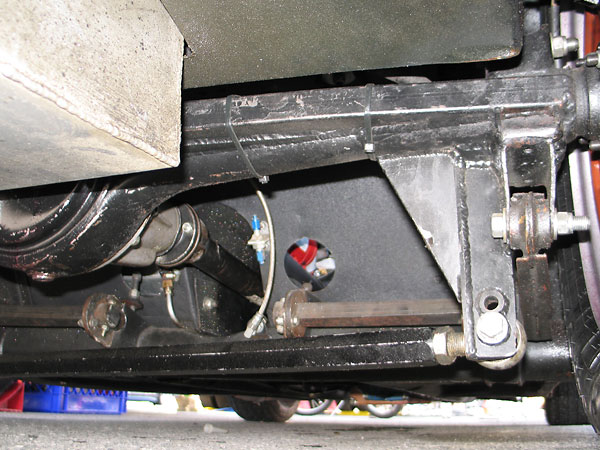
�
Heavily reinforced Austin A35 rear axle housing. Uncommonly far below the axle, a Panhard rod spans
�
from the righthand side of the axle to the lefthand side of the car's frame. The Panhard rod keeps
�
the axle centered under the car. The reason it's mounted so low is that its mounting height
�
determines the car's rear roll center. Note: no rear anti-roll bar on this Turner Mk1.
�
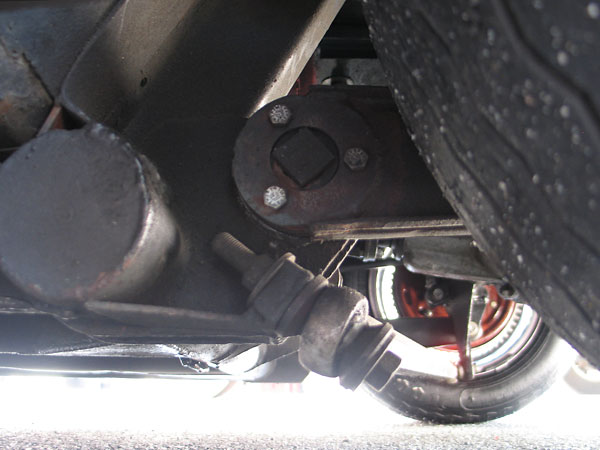
�
Close-up view of the Panhard rod's attachment to the frame, below the left side torsion spring.
�
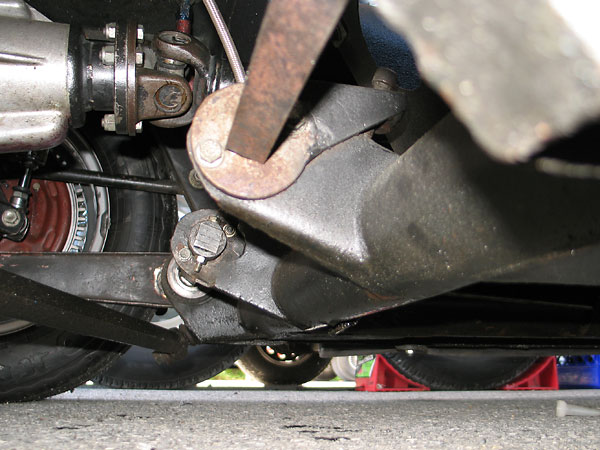
�
One of the advantages of torsion springs is that they make ride height adjustment simple.
�
Just crank on the bolts that rotate/locate the inboard ends of the torsion bars! No floor jack?
�
If you like, you can get to the adjustment bolts through access holes behind the seats.
�
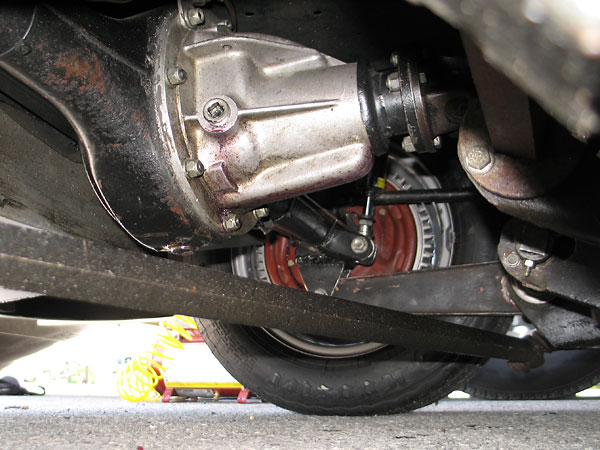
�
In this view you can glimpse the aluminum finned rear brake drums and also the aluminum
�
differential carrier, but I was trying to photograph one of the upper trailing links
�
that connect the rear axle to the frame.
�
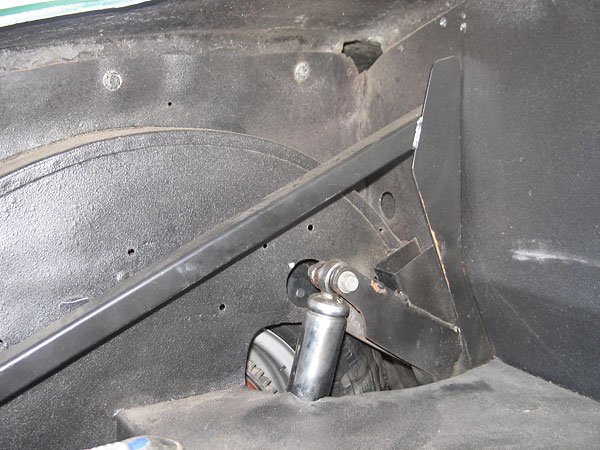
�
Turners used telescoping shock absorbers at the rear. These are Carrera Hypershock gas-charged shocks.
�
�
Interior
��
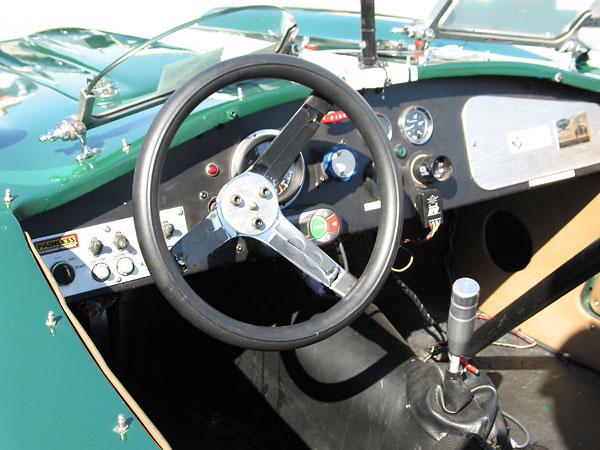
�
Cockpit of a 1959 Turner Sports Mk1 vintage racecar.
�
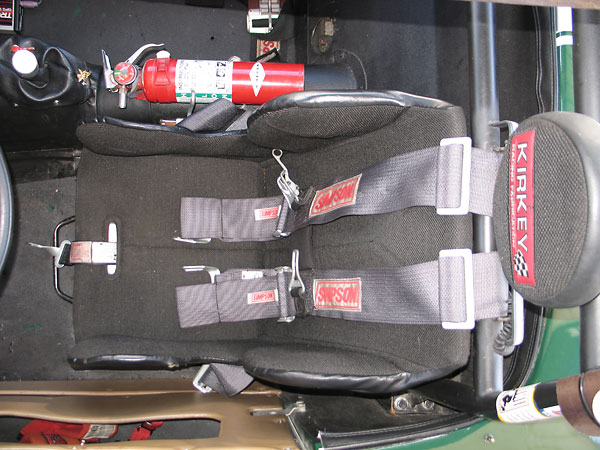
�
Kirkey Economy Oval Track seat with its original high backrest cut off to comply with Vintage Sports
�
Car Club of America rules that at the time didn't allow high backrests. GMT Racing fabricated an
�
adjustable height headrest, and upholstered it with material from Kirkey's original cushion.
�
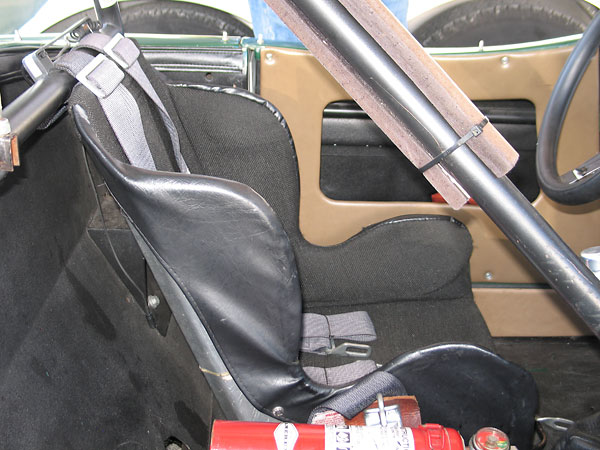
�
Simpson five point latch and link harness. Note also the thick padding on the roll hoop brace.
�
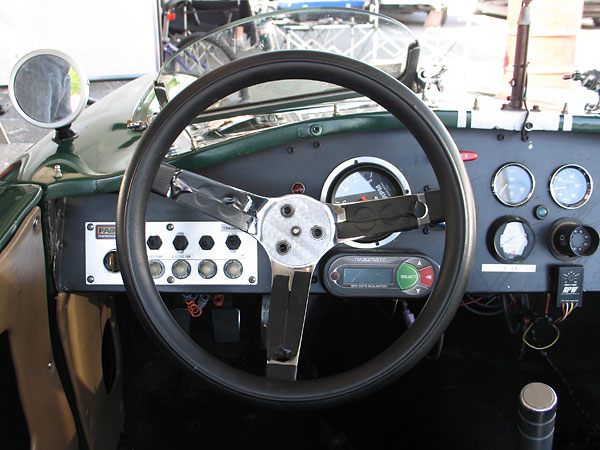
�
This Grant steering wheel is rubber padded for comfort. Decorative holes in the wheel's spokes
�
have been taped over to keep the driver's fingers out of them. Large holes in steering wheel
�
spokes aren't adviseable because steering wheels tend to jerk violently during accidents.
�
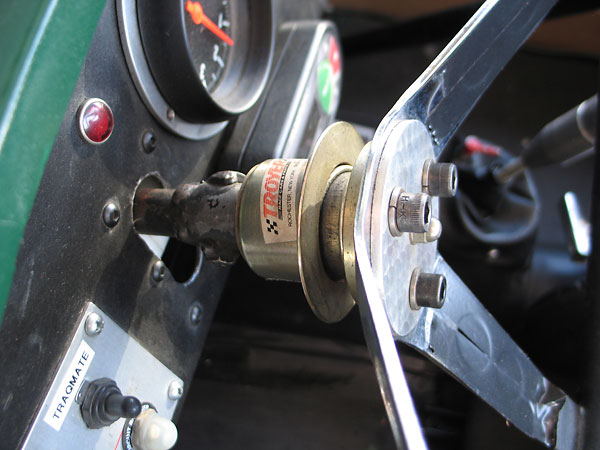
�
Troyer quick release steering wheel hub.
�
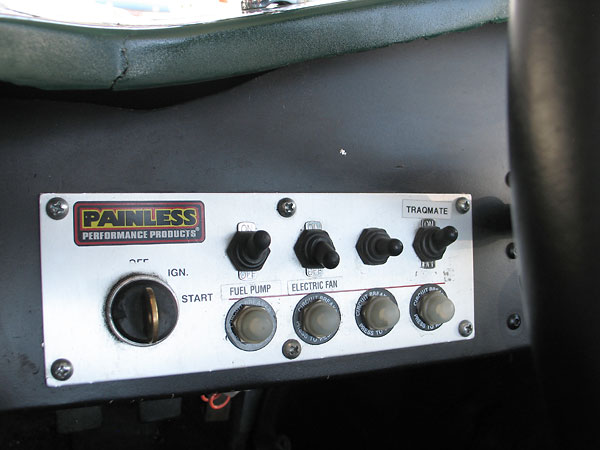
�
Painless Performance Products switch panel, with four fuses.
�
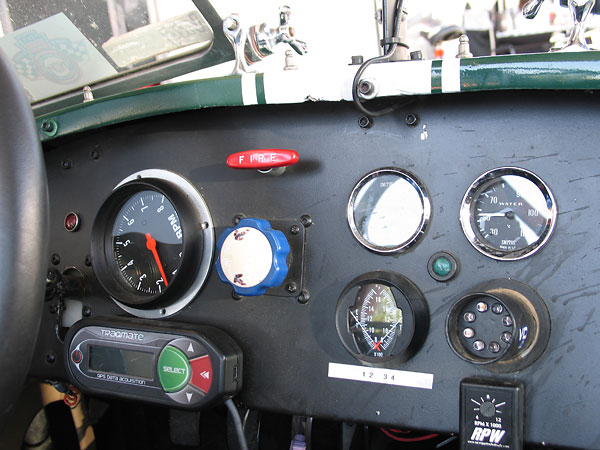
�
The blue knob is for fore and aft brake balance adjustment. Below it is a TraqMate GPS-based
�
data acquisition system controller. To the right: a Westach dual exhaust gas temperature gauge.
�
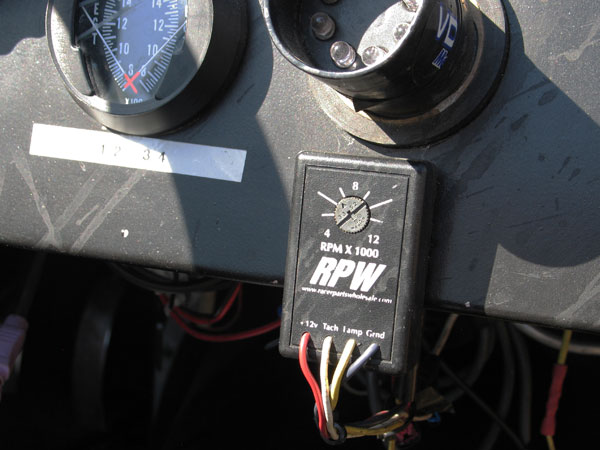
�
This Racer Parts Wholesale electronic rev-limiter appears to be set to 6500rpm, but Paul tells us
�
he normally races with it set at 7500rpm. In either case, a lower shift point is chosen to limit
�
wear and tear. As currently built, the engine will happily wind to 9000rpm when necessary.
�
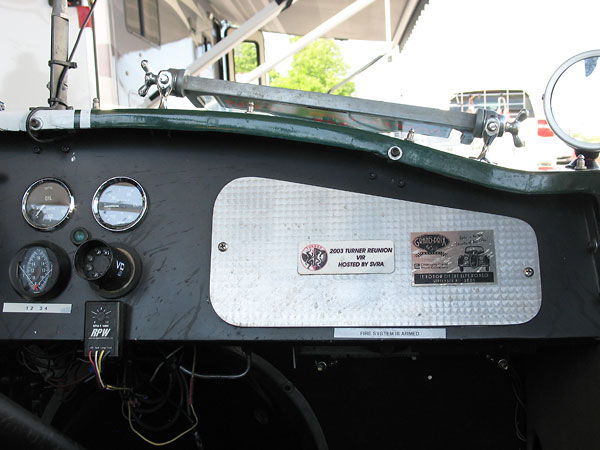
�
"FIRE SYSTEM IS ARMED" - the aluminum cover hides the bottle of a fire suppression system.
�
(The original Turner glove box didn't have a lid.) Decals on the cover read as follows:
�
"Watkins Glen Vintage Grand Prix - Return to the Streets of the Glen! - Presented by
�
Chemung Canal Trust Company - In Honor of the Alfa Romeo - September 9, 2005", and
�
"2003 Turner Reunion - Virginia International Raceway - Hosted by SVRA"
�
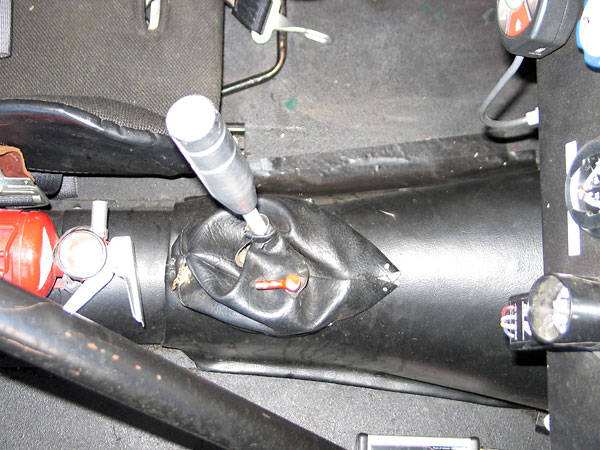
�
A red pin is used to block off the gear selector's reverse gear gate.
�
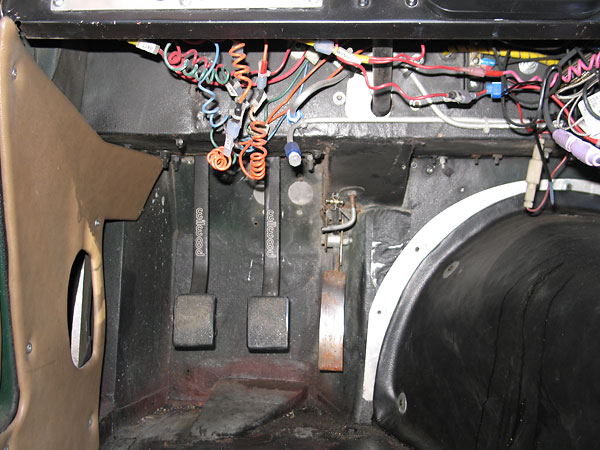
�
Wilwood hanging clutch and brake pedal assembly.
�
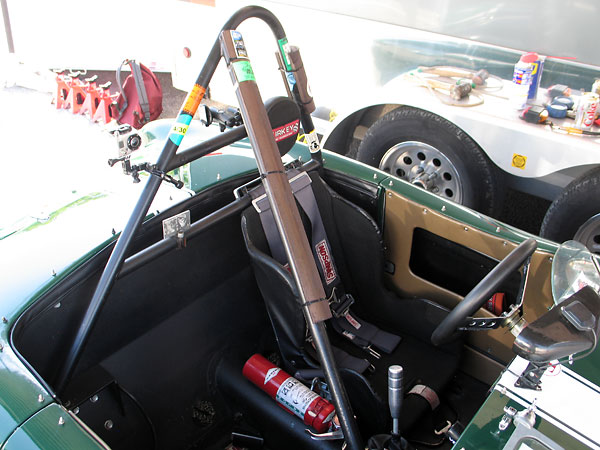
�
Roll hoop construction details.
�
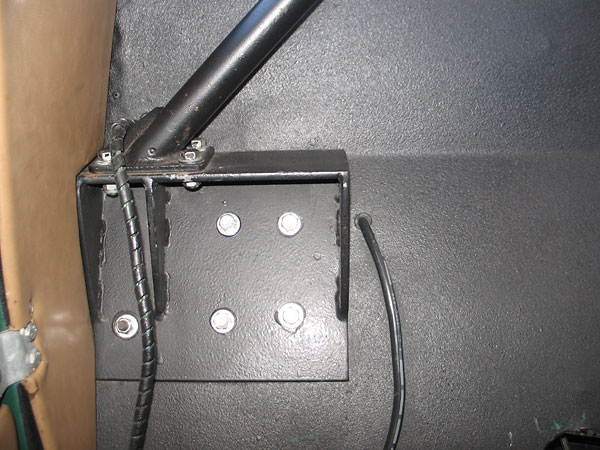
�
Roll hoop mounting bracket.
�
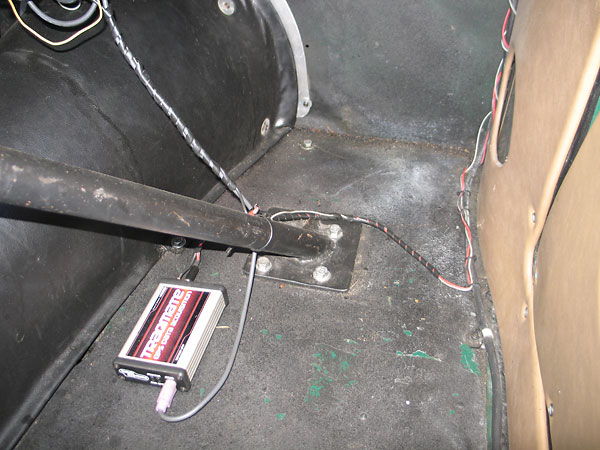
�
Roll hoop forward brace mounting bracket.
�
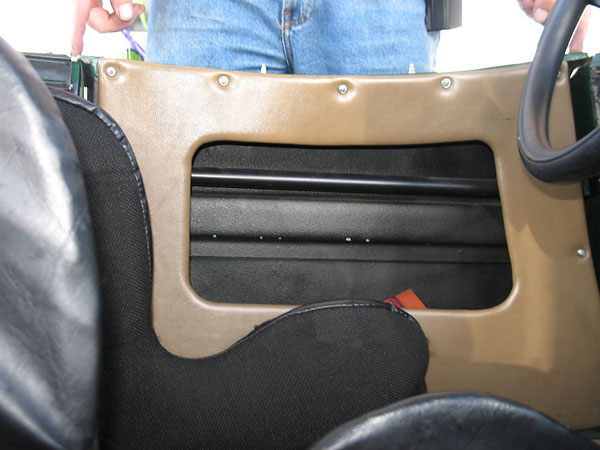
�
A tubular steel brace has been added inside the driver-side door.
�
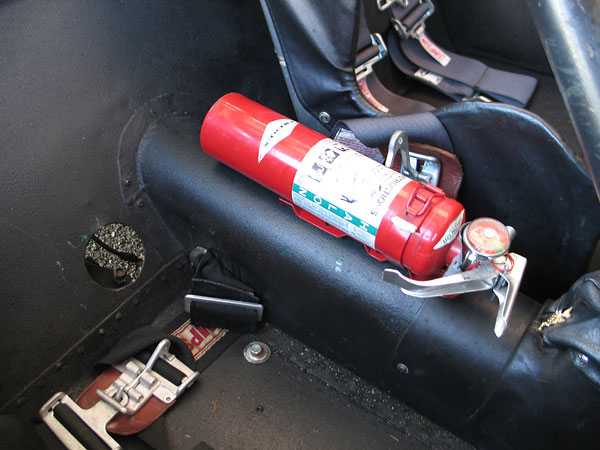
�
Amerex handheld Halon fire extenguisher.
�
�
Exterior
��
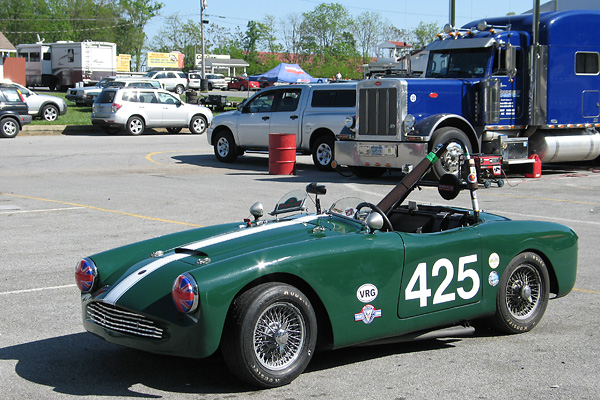
�
This photo is from the 2010 Jefferson 500, held at Summit Point West Virginia, but we also saw
�
Paul and his Turner more recently at the 29th annual Lime Rock Historic Festival in September
�
2011. Paul lapped that historic little 1.51 mile racetrack in 1:10.534, which works out to a
�
very quick 77.35mph. Paul finished sixth place of 32 in both of Saturday's Group 3 races.
�
�
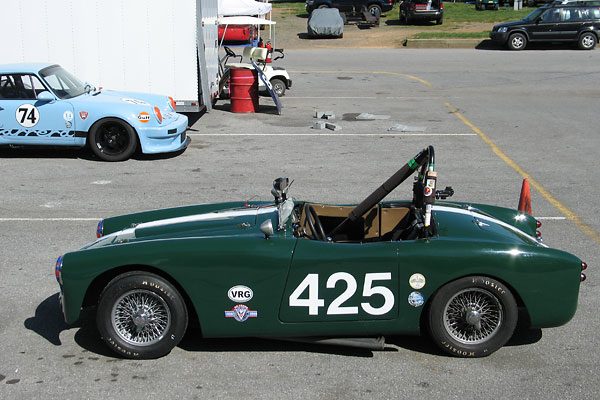
�
Jack Turner: born April 1st 1916, died March 7th 2011.
�
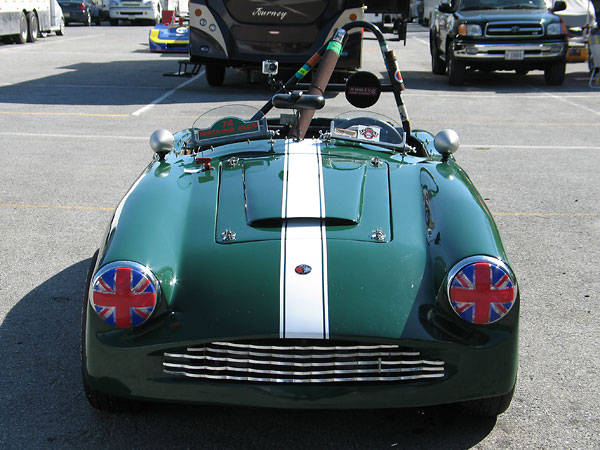
�
At the 2006 Pittsburg Vintage Grand Prix, Paul won the under-one-liter (Group 1) race!
�
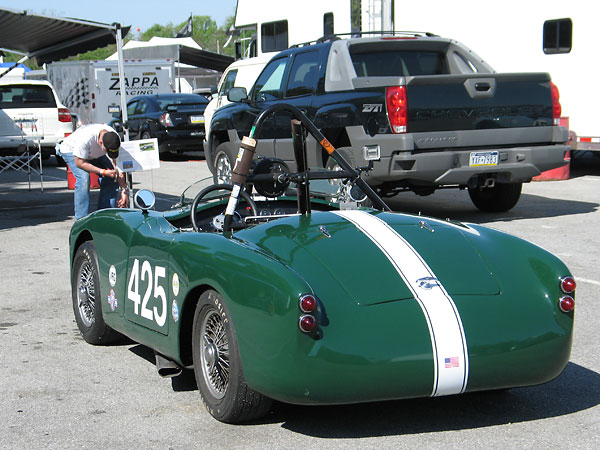
�
Turner car bodies are almost entirely fiberglass, with the notable exception of (aluminum) door skins.
�
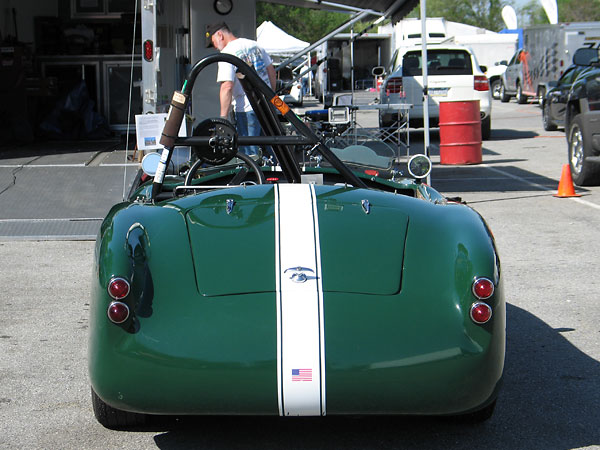
�
The Turner Mk1 was direct competition for the Austin Healey Sprite. One advantage of the Turner was
�
that it came with a boot lid. On a Mk1 Sprite, luggage has to be tucked in from behind the seats.
�
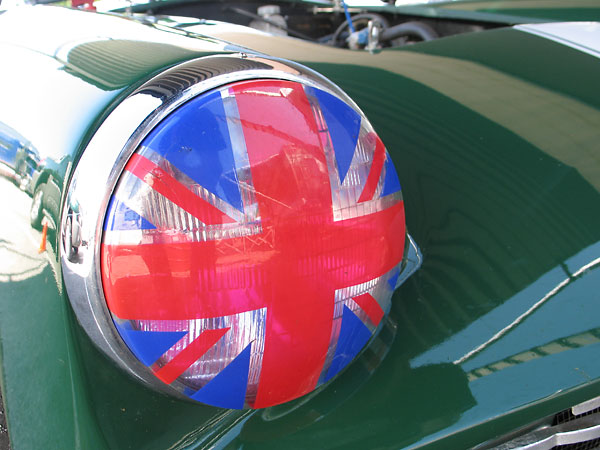
�
Historically, sportscar racers have taped over their headlamp lenses so broken glass
�
will be easier to clean up in the event they get smashed. Paul does the job with style.
�
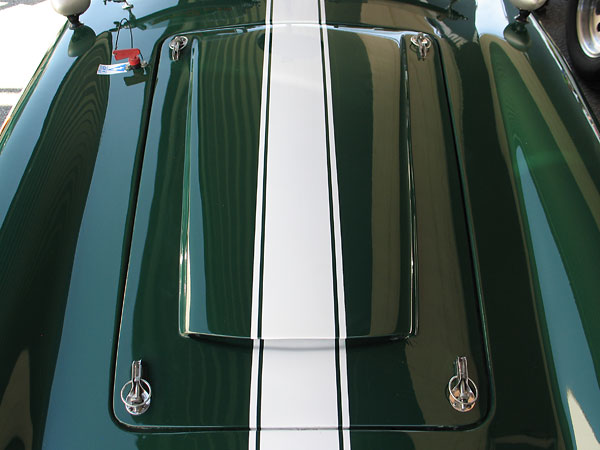
�
The bonnet is mounted on four OMP aluminum hood pins.
�
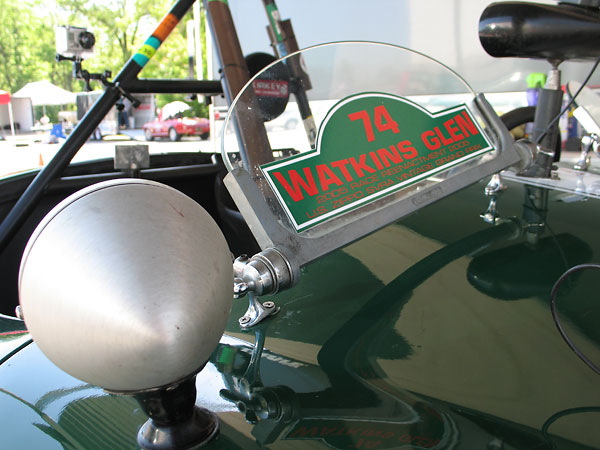
�
The decal on the passenger side Brooklands windscreen reads: "74 - Watkins Glen
�
2005 Race Reenactment - U.S. Zippo SVRA Vintage Grand Prix"
�
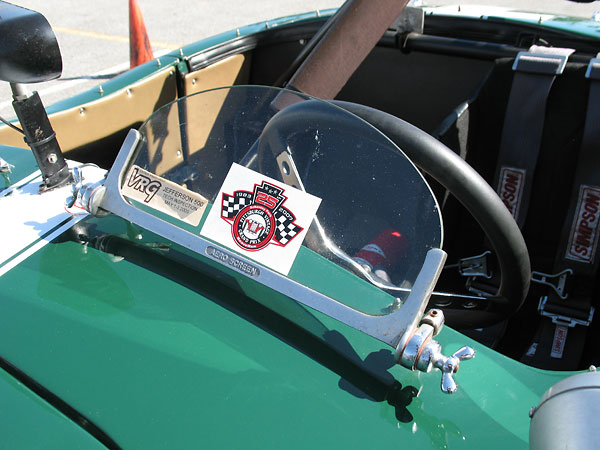
�
The decals on the passenger side Brooklands (Aero Screen) windscreen read:
�
"VRG Jefferson 500 Tech Inspection - May 1-3, 2009" and
�
"25th Pittsburgh Vintage Grand Prix - 1983-2007 - Shenley Park / BeaveRun"
�
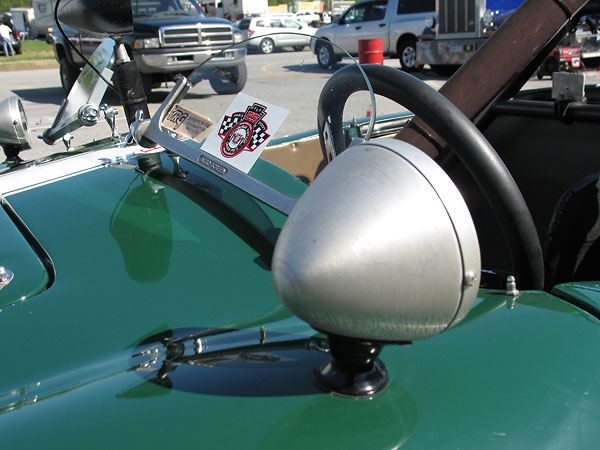
�
GT Classic side view mirror.
�
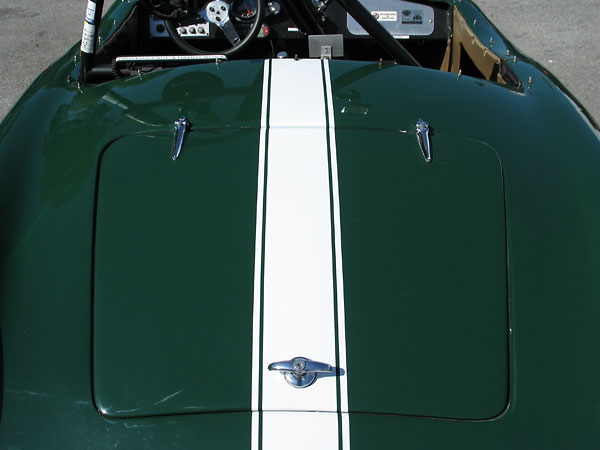
�
Turner Mk1 boot lid.
�
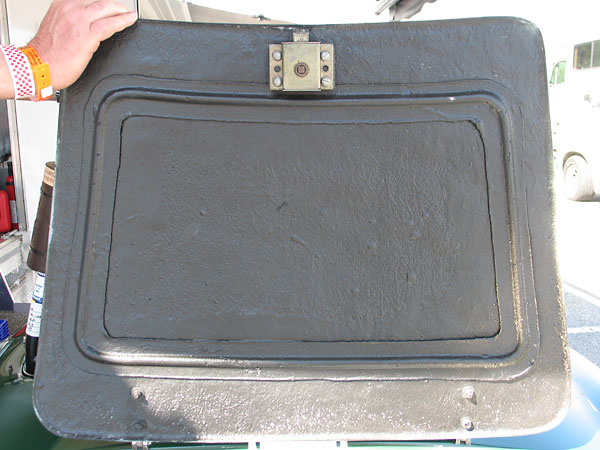
�
Boot lid, opened for access to the fuel cell.
�
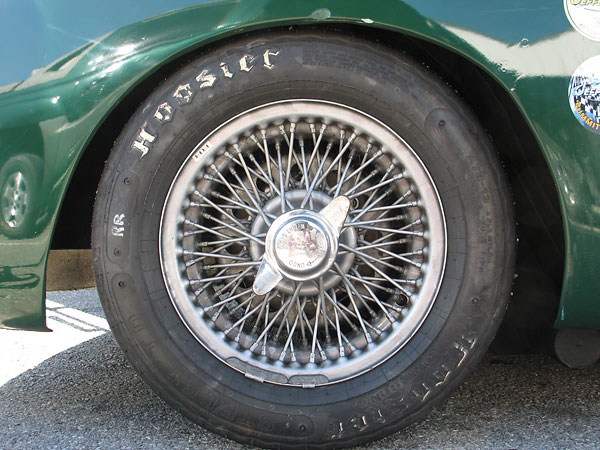
�
Dunlop 72-spoke wheels.
�
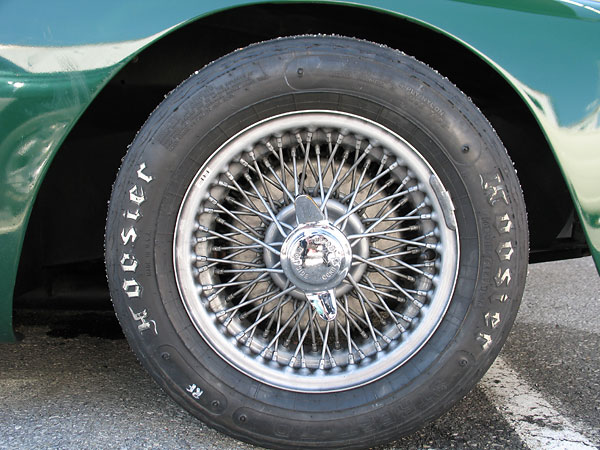
�
Hoosier Street T.D. tires (A70-13).
�
�
Except for the very first photo at the top of the article, all photos shown here are from�
April 2010 when we viewed the Turner Mk1 at VRG's Jefferson 500 at Summit Point Motorsports Park�
in West Virginia. The other photo is from the Lime Rock Historic Festival of September 2011.�
All photos by Curtis Jacobson for BritishRaceCar.com, copyright 2012. All rights reserved.
�
| If you liked this article, you'll probably also enjoy these: | �|||||
 | �
Bill Thumel '61 Elva Courier | �
 | �
Andy Seward '62 Marcos GT | �
 | �
Vic Schuster '65 Turner MkIII | �
| You're invited to discuss anything you've seen here on The British Racecar Motorsports Forum! | �|||||
�
Notice: all the articles and almost all the photos on BritishRacecar.com are by Curtis Jacobson.
�
(Photos that aren't by Curtis are explicitly credited.) Reproduction without prior written permission is prohibited.
�
Contact us to purchase images or reproduction permission. Higher resolution images are optionally available.
�

 �
�